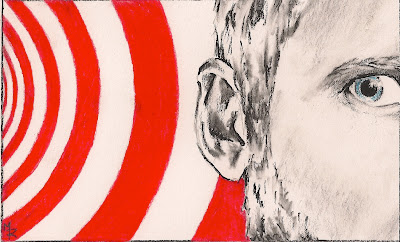Faith Comes By Hearing
 |
| Faith Comes by Hearing, 2011 (Charcoal and Color Pencil) |
So I was asked to do a self-portrait in my class on the arts and theology. This is what I came up with as I was thinking more about what Paul meant by "Faith comes by hearing" in Romans 10:17. I wanted to consider more fully what it means for the "external Word" (Article V of the AC) to come and create faith within the hearer. These waves are expressed by the red and white lines that reverberate in the background. Those colors also allude to elements of the Gospel message. (Red - Both life and death and White - purity and holiness). It's a message that calls us to die to our sins and live to God in Christ Jesus our Lord. The reverberations themselves of the word are something in real time and space as God's Word enters creation to instill faith within us. Not only is God's word to us an external Word, it is also an embodied/physical Word (leibliches Wort). The incarnation of the Word was never more present in Jesus. It continues to be embodied when Christ's body, the Church speaks his Word of forgiveness in Preaching and Sacraments.
The other part of this drawing that I am trying to flesh out is how we talk about the sense of sight, which also is God given. What I am trying to portray here is how the received Word of God that creates faith can and does inform our eyes to some degree. It informs our eyes to be eyes of faith. To learn the recognition of what is beautiful not in our eyes, but in the eyes of God. It is a beauty that looks at things anew. Chief example that I can think of right now is the Sacraments (Baptism, Communion, and Confession/Absolution if you name 3). To the world, it looks like another set of rituals with a little water or bread and wine. But when combined with the Word of God, they become the "visible Word" as St. Augustine calls them. In this sense, the visual becomes a language that cooperates with the spoken. We are called to see God's Word attached to these elements. In that sense, the Holy Supper is eschatological in that it allows us to taste and see that God is good. We desire to see fully, unfortunately, the sin that still pervades our being prevents us from beholding its fullness. As we desire to see (as shown by the epicenter that is at the same level as the eye), the Lord gives us veiled glimpses of that future glory. May he teach us to recognize them when they are presented to us.

